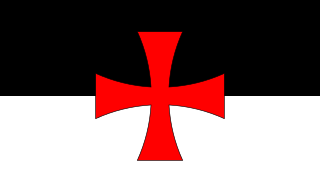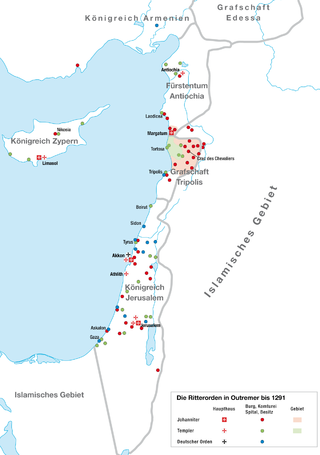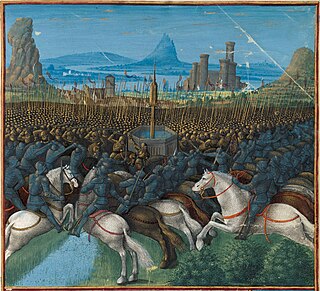Related Research Articles

The Poor Fellow-Soldiers of Christ and of the Temple of Solomon, mainly known as the Knights Templar, was a French military order of the Catholic faith, and one of the wealthiest and most popular military orders in Western Christianity. They were founded c. 1119 to defend pilgrims on their way to Jerusalem, with their headquarters located there on the Temple Mount, and existed for nearly two centuries during the Middle Ages.

The Battle of Hattin took place on 4 July 1187, between the Crusader states of the Levant and the forces of the Ayyubid sultan Saladin. It is also known as the Battle of the Horns of Hattin, due to the shape of the nearby extinct volcano of that name.

A military order is a Christian religious society of knights. The original military orders were the Knights Templar, the Knights Hospitaller, the Order of the Holy Sepulchre, the Order of Saint James, the Order of Calatrava, and the Teutonic Knights. They arose in the Middle Ages in association with the Crusades, in the Holy Land, the Baltics, and the Iberian peninsula; their members being dedicated to the protection of pilgrims and Christians, as well as the defence of the Crusader states. They are the predecessors of chivalric orders.

During the period of the Crusades, turcopoles were locally recruited mounted archers and light cavalry employed by the Byzantine Empire and the Crusader states. A leader of these auxiliaries was designated as Turcopolier, a title subsequently given to a senior officer in the Knights Templars and the Order of the Hospital of St John of Jerusalem, in charge of the coastal defences of Rhodes and Malta. In addition to the two Military Orders, the army of the Kingdom of Jerusalem employed king's Turcoples under the direction of a Grand Turcopolier.

The Battle of Cresson was a small battle between Frankish and Ayyubid forces on 1 May 1187 at the "Spring of the Cresson." While the exact location of the spring is unknown, it is located in the environs of Nazareth. The conflict was a prelude to the decisive defeat of the Kingdom of Jerusalem at the Battle of Hattin two months later.

The Military Order of Our Lord Jesus Christ is the former order of Knights Templar as it was reconstituted in Portugal. Before 1910, it was known as the Royal Military Order of Our Lord Jesus Christ, and the Order of the Knights of Our Lord Jesus Christ. It was founded in 1319, with the protection of King Denis of Portugal, after the Templars were abolished on 22 March 1312 by the papal bull, Vox in excelso, issued by Pope Clement V. King Denis refused to pursue and persecute the former knights as had occurred in most of the other sovereign states under the political influence of the Catholic Church.
Leonard Eugene Boyle, OP was an Irish and Canadian scholar in medieval studies and palaeography.

Douglas James Davies, is a Welsh Anglican theologian, anthropologist, religious leader and academic, specialising in the history, theology, and sociology of death. He is Professor in the Study of Religion at the University of Durham. His fields of expertise also include anthropology, the study of religion, the rituals and beliefs surrounding funerary rites and cremation around the globe, Mormonism and Mormon studies. His research interests cover identity and belief, and Anglican leadership.

Robin Attfield is a British philosopher known for his work on environmental philosophy, ethics, the history of philosophy and the philosophy of religion. He is an Emeritus Professor of Philosophy at Cardiff University.
Milites were the trained regular footsoldiers of ancient Rome, and later a term used to describe "soldiers" in Medieval Europe.
The Battle of Nish was fought between the Crusaders led by John Hunyadi and Đurađ Branković and the Ottoman Empire led by Kasim Pasha. It saw the Crusaders capture the Ottoman stronghold of Nish (Niš) in Serbia, and defeat two armies of the Ottoman Empire. The Battle of Nish was part of Hunyadi's expedition known as the long campaign. Hunyadi, at the head of the vanguard, crossed the Balkans through the Gate of Trajan, captured Nish, defeated three Ottoman pashas, and after taking Sofia from the Ottomans, united with the royal army and defeated Sultan Murad II at Snaim (Kustinitza). The impatience of the king and the severity of the winter then compelled him to return home.
Malcolm Charles Barber is a British medievalist. He has been described as the world's leading living expert on the Knights Templar. He is considered to have written the two most comprehensive books on the subject, The Trial of the Templars (1978) and The New Knighthood: A History of the Order of the Temple (1994). He has been an editor for The Journal of Medieval History and written many articles on the Templars, the Cathars, various elements of the Crusades, and the reign of Philip IV of France.

The Battle of Kunovica or Battle at Kunovitsa was fought between crusaders led by John Hunyadi and the armies of the Ottoman Empire on 2 or 5 January 1444, near the mountain Kunovica between Pirot and Niš, in present-day Serbia. It was part of the larger Crusade of Varna.
Paul G. Halpern is a retired American educator, naval historian and documentary editor. His primary focus has been the history of the Royal Navy in the period surrounding the First World War and in Naval warfare in the Mediterranean during World War I. In describing his career of achievement in publishing six volumes of edited naval documents, "The Annual Report of the Council of the Navy Records Society" noted in 2016 that "Paul Halpern has served the Society notably". "Those who have edited a similar number are a distinguished group: Sir Julian Corbett, Michael Oppenheim, Professor David Syrett, and J. R. Tanner, while only Sir John Knox Laughton and the Admiralty Librarian David Bonner-Smith have outstripped him."
Crusade Texts in Translation is a book series of English translations of texts about the Crusades published initially by Ashgate in Farnham, Surrey and Burlington, Vermont, and currently by Routledge. Publication began in May 1996. The editors of the series, all from the United Kingdom, are Malcolm Barber, University of Reading; Peter Edbury, Cardiff University; Bernard Hamilton, University of Nottingham; Norman Housley, University of Leicester; and Peter Jackson, University of Keele.
Esquieu de Floyran was a prior of Montfaucon in the Abbey of Saint Martial in Limoges.
Jean de Ronay was knight of the Order of Saint John of Jerusalem who was appointed Grand Commander of the Knights Hospitaller by the Grand Master Guillaume de Chateauneuf in 1243 or 1244. He served as interim Grand Master of the Knights Hospitaller from 1244 to 1250 during the captivity of de Chateauneuf. He died in battle during the Seventh Crusade.
This list of works on the history of the Crusades and their mainly Muslim opponents, provides a select bibliography of modern works that are frequently cited in books, papers and articles that discuss these "holy wars". Thousands of histories on these topics have been published between the 11th and 21st centuries; this page only lists modern works on the topic. Works included are referenced in the notes or bibliographies of scholarly secondary sources or journals. Included works are: published by an independent academic or notable non-governmental publisher; authored by an independent and notable subject matter expert; or have significant independent scholarly journal reviews.
Alan V. Murray is a Scottish historian and philologist specializing in the history of the Crusades, medieval warfare and tournaments, and Middle High German language and literature. He is Professor of Medieval European History at the University of Leeds and a former Director of the International Medieval Bibliography (IMB).
References
- ↑ "Interview with... Helen Nicholson". All About History. 7 December 2017. Retrieved 2019-05-30– via pressreader.
- 1 2 "Dr Helen J Nicholson". Resources for Studying the Crusades at Queen Mary University of London. Retrieved 2019-05-30.
- 1 2 Nicholson, Helen J. (1989). Images of the military orders, 1128–1291: Spiritual, secular, romantic (PhD). University of Leicester.